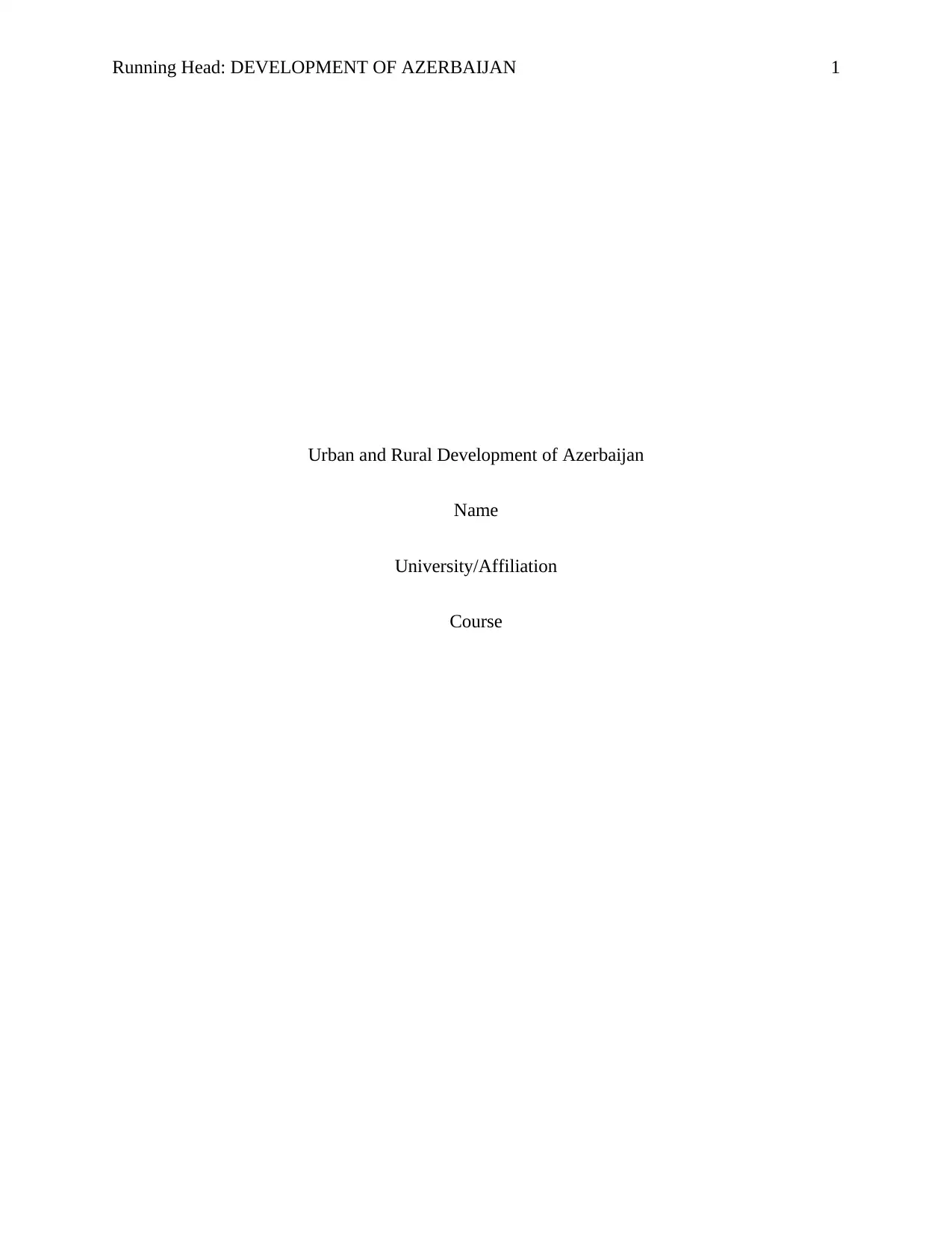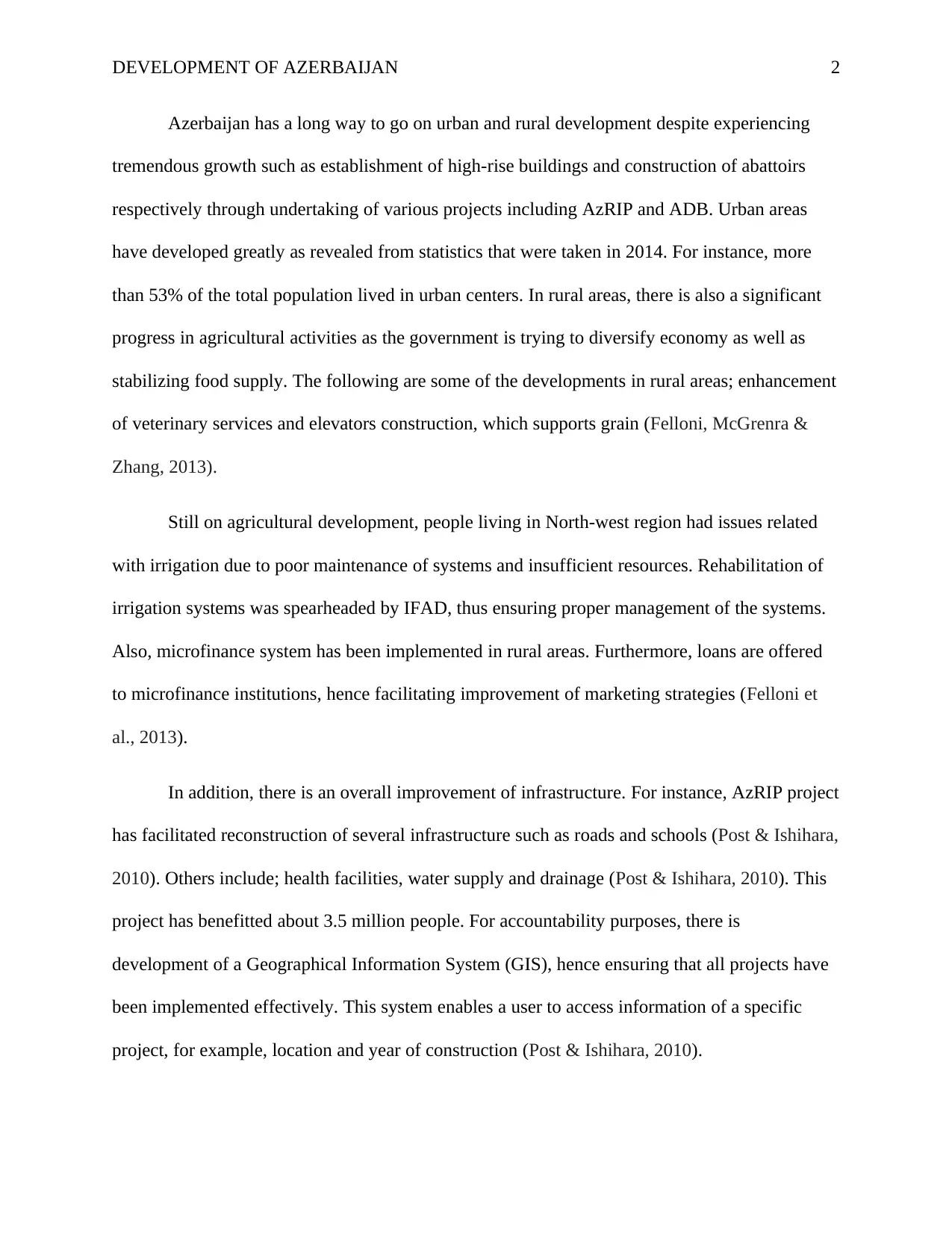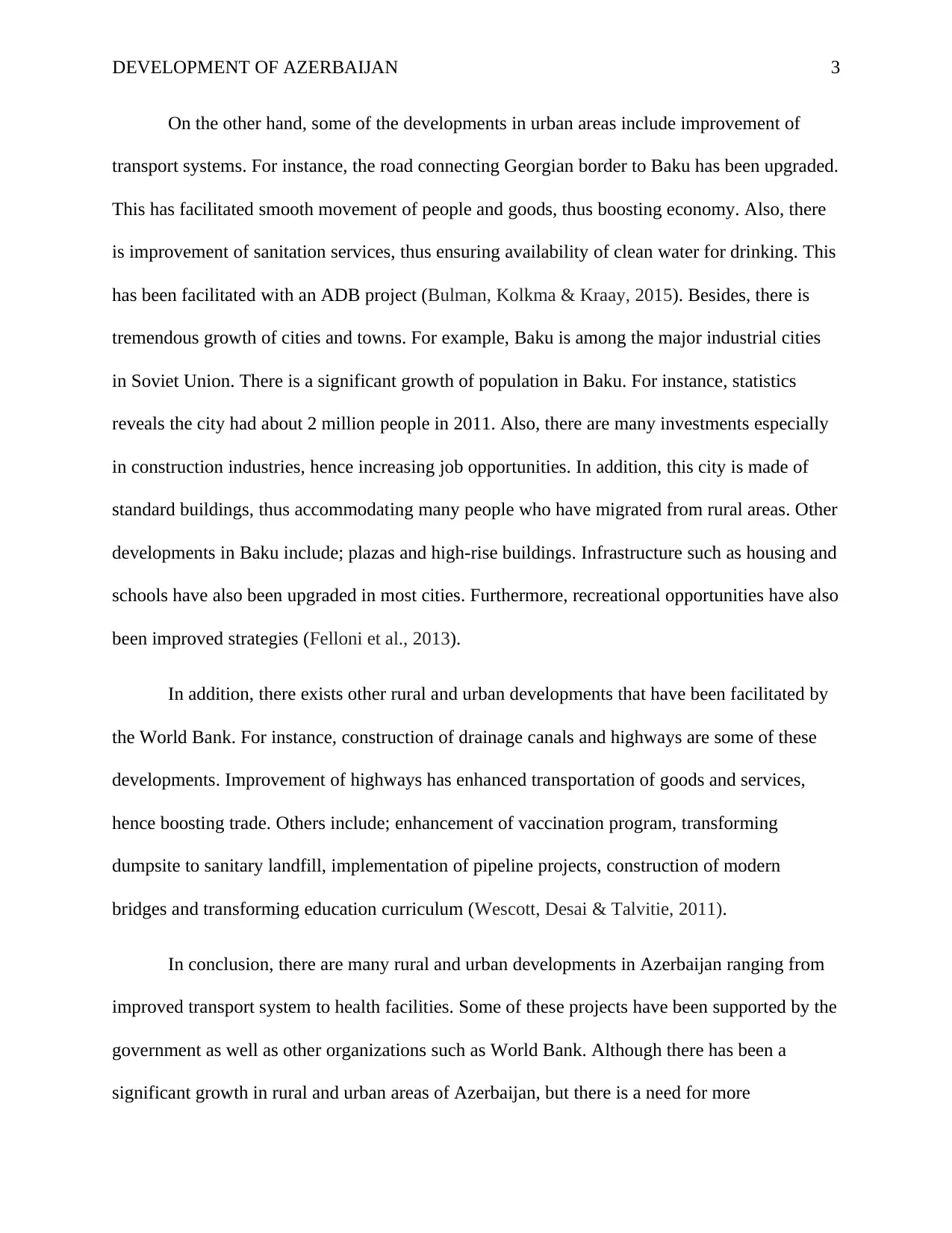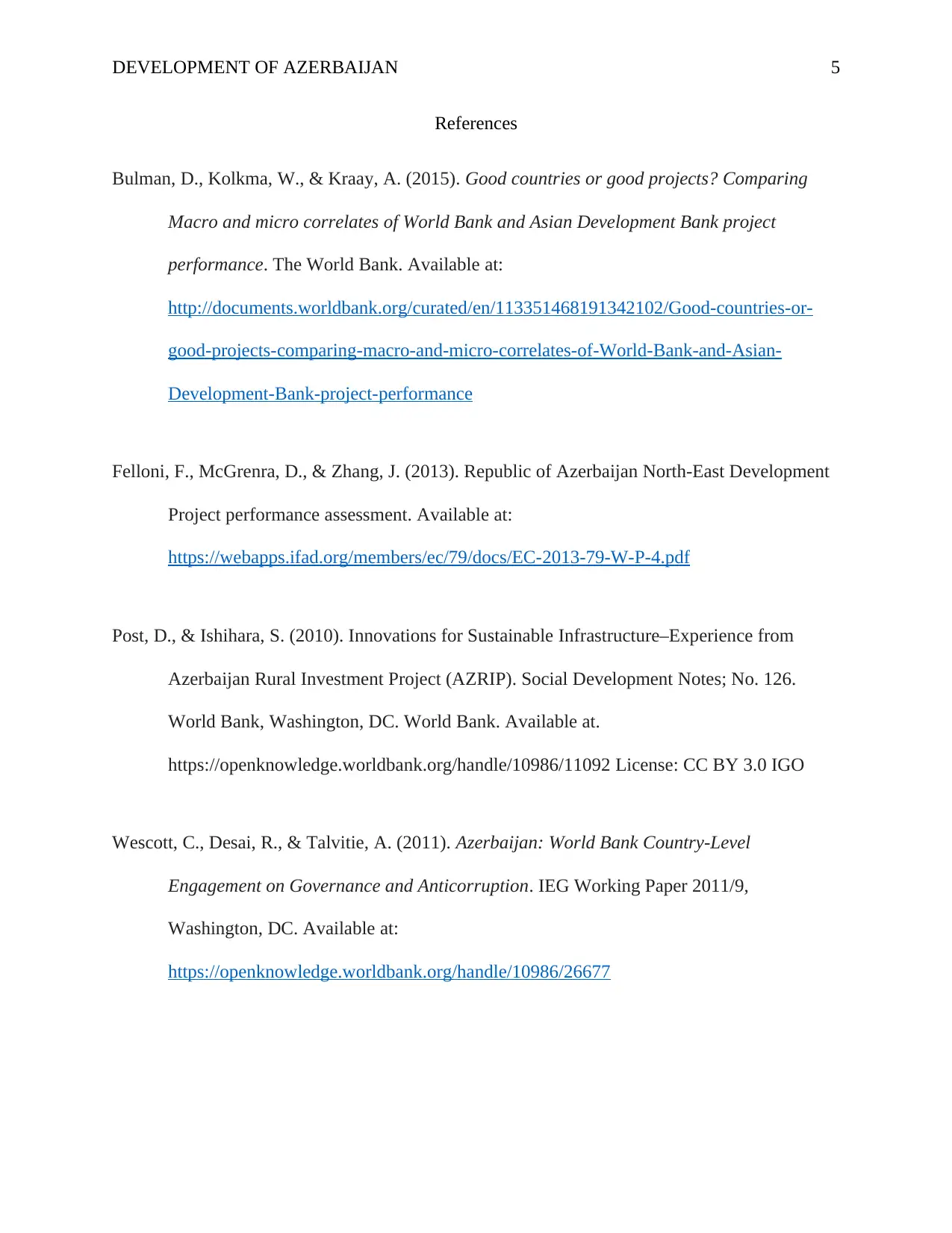GINS 1100 - Analysis of Urban and Rural Development in Azerbaijan
VerifiedAdded on 2023/05/31
|6
|945
|158
Report
AI Summary
This report provides an in-depth analysis of the urban and rural development in Azerbaijan. It examines the significant progress made in both urban and rural areas, highlighting key projects like AzRIP and ADB initiatives. The report details the development of infrastructure, including roads, schools, and health facilities, as well as advancements in agricultural practices, such as the enhancement of veterinary services and irrigation systems. It also explores the growth of urban centers like Baku, focusing on improvements in transport, sanitation, and housing. The report references various studies and projects, including those supported by the World Bank, and concludes with a call for continued investment in infrastructure and rural development to address remaining challenges and reduce urban migration.

Running Head: DEVELOPMENT OF AZERBAIJAN 1
Urban and Rural Development of Azerbaijan
Name
University/Affiliation
Course
Urban and Rural Development of Azerbaijan
Name
University/Affiliation
Course
Paraphrase This Document
Need a fresh take? Get an instant paraphrase of this document with our AI Paraphraser

DEVELOPMENT OF AZERBAIJAN 2
Azerbaijan has a long way to go on urban and rural development despite experiencing
tremendous growth such as establishment of high-rise buildings and construction of abattoirs
respectively through undertaking of various projects including AzRIP and ADB. Urban areas
have developed greatly as revealed from statistics that were taken in 2014. For instance, more
than 53% of the total population lived in urban centers. In rural areas, there is also a significant
progress in agricultural activities as the government is trying to diversify economy as well as
stabilizing food supply. The following are some of the developments in rural areas; enhancement
of veterinary services and elevators construction, which supports grain (Felloni, McGrenra &
Zhang, 2013).
Still on agricultural development, people living in North-west region had issues related
with irrigation due to poor maintenance of systems and insufficient resources. Rehabilitation of
irrigation systems was spearheaded by IFAD, thus ensuring proper management of the systems.
Also, microfinance system has been implemented in rural areas. Furthermore, loans are offered
to microfinance institutions, hence facilitating improvement of marketing strategies (Felloni et
al., 2013).
In addition, there is an overall improvement of infrastructure. For instance, AzRIP project
has facilitated reconstruction of several infrastructure such as roads and schools (Post & Ishihara,
2010). Others include; health facilities, water supply and drainage (Post & Ishihara, 2010). This
project has benefitted about 3.5 million people. For accountability purposes, there is
development of a Geographical Information System (GIS), hence ensuring that all projects have
been implemented effectively. This system enables a user to access information of a specific
project, for example, location and year of construction (Post & Ishihara, 2010).
Azerbaijan has a long way to go on urban and rural development despite experiencing
tremendous growth such as establishment of high-rise buildings and construction of abattoirs
respectively through undertaking of various projects including AzRIP and ADB. Urban areas
have developed greatly as revealed from statistics that were taken in 2014. For instance, more
than 53% of the total population lived in urban centers. In rural areas, there is also a significant
progress in agricultural activities as the government is trying to diversify economy as well as
stabilizing food supply. The following are some of the developments in rural areas; enhancement
of veterinary services and elevators construction, which supports grain (Felloni, McGrenra &
Zhang, 2013).
Still on agricultural development, people living in North-west region had issues related
with irrigation due to poor maintenance of systems and insufficient resources. Rehabilitation of
irrigation systems was spearheaded by IFAD, thus ensuring proper management of the systems.
Also, microfinance system has been implemented in rural areas. Furthermore, loans are offered
to microfinance institutions, hence facilitating improvement of marketing strategies (Felloni et
al., 2013).
In addition, there is an overall improvement of infrastructure. For instance, AzRIP project
has facilitated reconstruction of several infrastructure such as roads and schools (Post & Ishihara,
2010). Others include; health facilities, water supply and drainage (Post & Ishihara, 2010). This
project has benefitted about 3.5 million people. For accountability purposes, there is
development of a Geographical Information System (GIS), hence ensuring that all projects have
been implemented effectively. This system enables a user to access information of a specific
project, for example, location and year of construction (Post & Ishihara, 2010).

DEVELOPMENT OF AZERBAIJAN 3
On the other hand, some of the developments in urban areas include improvement of
transport systems. For instance, the road connecting Georgian border to Baku has been upgraded.
This has facilitated smooth movement of people and goods, thus boosting economy. Also, there
is improvement of sanitation services, thus ensuring availability of clean water for drinking. This
has been facilitated with an ADB project (Bulman, Kolkma & Kraay, 2015). Besides, there is
tremendous growth of cities and towns. For example, Baku is among the major industrial cities
in Soviet Union. There is a significant growth of population in Baku. For instance, statistics
reveals the city had about 2 million people in 2011. Also, there are many investments especially
in construction industries, hence increasing job opportunities. In addition, this city is made of
standard buildings, thus accommodating many people who have migrated from rural areas. Other
developments in Baku include; plazas and high-rise buildings. Infrastructure such as housing and
schools have also been upgraded in most cities. Furthermore, recreational opportunities have also
been improved strategies (Felloni et al., 2013).
In addition, there exists other rural and urban developments that have been facilitated by
the World Bank. For instance, construction of drainage canals and highways are some of these
developments. Improvement of highways has enhanced transportation of goods and services,
hence boosting trade. Others include; enhancement of vaccination program, transforming
dumpsite to sanitary landfill, implementation of pipeline projects, construction of modern
bridges and transforming education curriculum (Wescott, Desai & Talvitie, 2011).
In conclusion, there are many rural and urban developments in Azerbaijan ranging from
improved transport system to health facilities. Some of these projects have been supported by the
government as well as other organizations such as World Bank. Although there has been a
significant growth in rural and urban areas of Azerbaijan, but there is a need for more
On the other hand, some of the developments in urban areas include improvement of
transport systems. For instance, the road connecting Georgian border to Baku has been upgraded.
This has facilitated smooth movement of people and goods, thus boosting economy. Also, there
is improvement of sanitation services, thus ensuring availability of clean water for drinking. This
has been facilitated with an ADB project (Bulman, Kolkma & Kraay, 2015). Besides, there is
tremendous growth of cities and towns. For example, Baku is among the major industrial cities
in Soviet Union. There is a significant growth of population in Baku. For instance, statistics
reveals the city had about 2 million people in 2011. Also, there are many investments especially
in construction industries, hence increasing job opportunities. In addition, this city is made of
standard buildings, thus accommodating many people who have migrated from rural areas. Other
developments in Baku include; plazas and high-rise buildings. Infrastructure such as housing and
schools have also been upgraded in most cities. Furthermore, recreational opportunities have also
been improved strategies (Felloni et al., 2013).
In addition, there exists other rural and urban developments that have been facilitated by
the World Bank. For instance, construction of drainage canals and highways are some of these
developments. Improvement of highways has enhanced transportation of goods and services,
hence boosting trade. Others include; enhancement of vaccination program, transforming
dumpsite to sanitary landfill, implementation of pipeline projects, construction of modern
bridges and transforming education curriculum (Wescott, Desai & Talvitie, 2011).
In conclusion, there are many rural and urban developments in Azerbaijan ranging from
improved transport system to health facilities. Some of these projects have been supported by the
government as well as other organizations such as World Bank. Although there has been a
significant growth in rural and urban areas of Azerbaijan, but there is a need for more
⊘ This is a preview!⊘
Do you want full access?
Subscribe today to unlock all pages.

Trusted by 1+ million students worldwide

DEVELOPMENT OF AZERBAIJAN 4
developments. For example, the government should invest much on projects such as building of
modern hospitals and clinics. Besides, the government should also consider establishing more
developments in rural areas, thus reducing the number of people migrating from rural to urban
areas.
developments. For example, the government should invest much on projects such as building of
modern hospitals and clinics. Besides, the government should also consider establishing more
developments in rural areas, thus reducing the number of people migrating from rural to urban
areas.
Paraphrase This Document
Need a fresh take? Get an instant paraphrase of this document with our AI Paraphraser

DEVELOPMENT OF AZERBAIJAN 5
References
Bulman, D., Kolkma, W., & Kraay, A. (2015). Good countries or good projects? Comparing
Macro and micro correlates of World Bank and Asian Development Bank project
performance. The World Bank. Available at:
http://documents.worldbank.org/curated/en/113351468191342102/Good-countries-or-
good-projects-comparing-macro-and-micro-correlates-of-World-Bank-and-Asian-
Development-Bank-project-performance
Felloni, F., McGrenra, D., & Zhang, J. (2013). Republic of Azerbaijan North-East Development
Project performance assessment. Available at:
https://webapps.ifad.org/members/ec/79/docs/EC-2013-79-W-P-4.pdf
Post, D., & Ishihara, S. (2010). Innovations for Sustainable Infrastructure–Experience from
Azerbaijan Rural Investment Project (AZRIP). Social Development Notes; No. 126.
World Bank, Washington, DC. World Bank. Available at.
https://openknowledge.worldbank.org/handle/10986/11092 License: CC BY 3.0 IGO
Wescott, C., Desai, R., & Talvitie, A. (2011). Azerbaijan: World Bank Country-Level
Engagement on Governance and Anticorruption. IEG Working Paper 2011/9,
Washington, DC. Available at:
https://openknowledge.worldbank.org/handle/10986/26677
References
Bulman, D., Kolkma, W., & Kraay, A. (2015). Good countries or good projects? Comparing
Macro and micro correlates of World Bank and Asian Development Bank project
performance. The World Bank. Available at:
http://documents.worldbank.org/curated/en/113351468191342102/Good-countries-or-
good-projects-comparing-macro-and-micro-correlates-of-World-Bank-and-Asian-
Development-Bank-project-performance
Felloni, F., McGrenra, D., & Zhang, J. (2013). Republic of Azerbaijan North-East Development
Project performance assessment. Available at:
https://webapps.ifad.org/members/ec/79/docs/EC-2013-79-W-P-4.pdf
Post, D., & Ishihara, S. (2010). Innovations for Sustainable Infrastructure–Experience from
Azerbaijan Rural Investment Project (AZRIP). Social Development Notes; No. 126.
World Bank, Washington, DC. World Bank. Available at.
https://openknowledge.worldbank.org/handle/10986/11092 License: CC BY 3.0 IGO
Wescott, C., Desai, R., & Talvitie, A. (2011). Azerbaijan: World Bank Country-Level
Engagement on Governance and Anticorruption. IEG Working Paper 2011/9,
Washington, DC. Available at:
https://openknowledge.worldbank.org/handle/10986/26677

DEVELOPMENT OF AZERBAIJAN 6
⊘ This is a preview!⊘
Do you want full access?
Subscribe today to unlock all pages.

Trusted by 1+ million students worldwide
1 out of 6
Your All-in-One AI-Powered Toolkit for Academic Success.
+13062052269
info@desklib.com
Available 24*7 on WhatsApp / Email
![[object Object]](/_next/static/media/star-bottom.7253800d.svg)
Unlock your academic potential
Copyright © 2020–2025 A2Z Services. All Rights Reserved. Developed and managed by ZUCOL.

